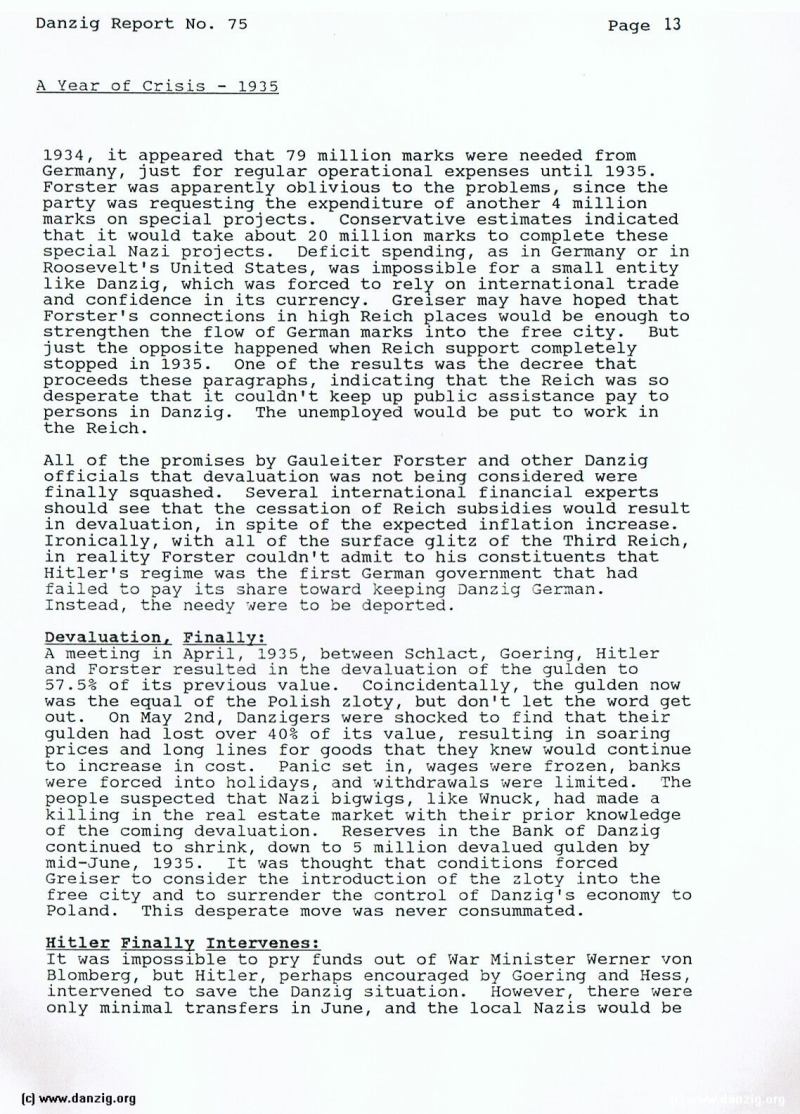
A year of Crisis — 1935
1934, it appeared that 79 million marks were needed from Germany, just for regular operational expenses until 1935. Forster was apparently oblivious to the problems, since the party was requesting the expenditure of another 4 million marks on special projects. Conservative estimates indicated that it would take about 20 million marks to complete these special Nazi projects. Deficit spending, as in Germany or in Roosevelt’s United States, was impossible for a small entity like Danzig, which was forced to rely on international trade and confidence in its currency. Greiser may have hoped that Forster’s connections in high Reich places would be enough to strengthen the flow of German marks into the free city. But just the opposite happened when Reich support completely stopped in 1935. One of the results was the decree that proceeds these paragraphs, indicating that the Reich was so desperate that it couldn’t keep up public assistance pay to persons in Danzig. The unemployed would be put to work in the Reich.
All of the promises by Gauleiter Forster and other Danzig officials that devaluation was not being considered were finally squashed. Several international financial experts should see that the cessation of Reich subsidies would result in devaluation, in spite of the expected inflation increase. Ironically, with all of the surface glitz of the Third Reich, in reality Forster couldn’t admit to his constituents that Hitler’s regime was the first German government that had failed to pay its share toward keeping Danzig German. Instead, the needy were to be deported.
Devaluation, Finally:
A meeting in April, 1935, between Schlact, Goering, Hitler and Forster resulted in the devaluation of the gulden to 57.5% of its previous value. Coincidentally, the gulden now was the equal of the Polish zloty, but don’t let the word get out. On May 2nd, Danzigers were shocked to find that their gulden had lost over 40% of its value, resulting in soaring prices and long lines for goods that they knew would continue to increase in cost. Panic set in, wages were frozen, banks were forced into holidays, and withdrawals were limited. The people suspected that Nazi bigwigs, like Wnuck, had made a killing in the real estate market with their prior knowledge of the coming devaluation. Reserves in the Bank of Danzig continued to shrink, down to 5 million devalued gulden by mid—June, 1935. It was thought that conditions forced Greiser to consider the introduction of the zloty into the free city and to surrender the control of Danzig’s economy to Poland. This desperate move was never consummated.
Hitler Finally Intervenes:
It was impossible to pry funds out of War Minister Werner von Blomberg, but Hitler, perhaps encouraged by Coering and Hess, intervened to save the Danzig situation. However, there were only minimal transfers in June, and the local Nazis would be
Danzig Report Vol. 1 - Nr. 75 - April - May - June - 1992, Page 13.
Hits: 1611
Added: 02/07/2015
Copyright: 2024 Danzig.org

